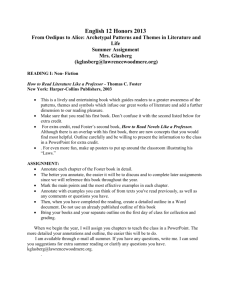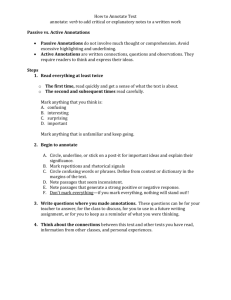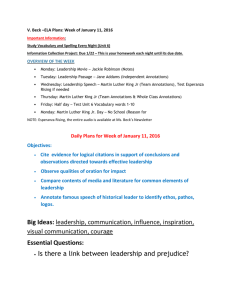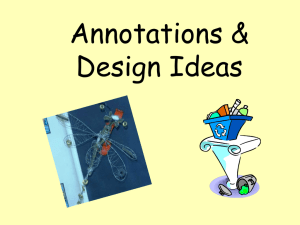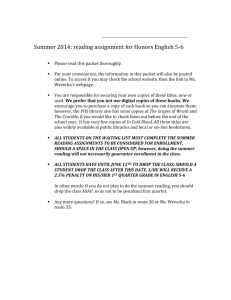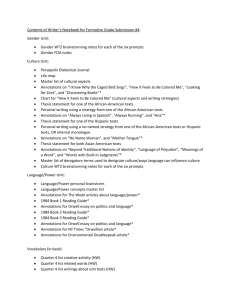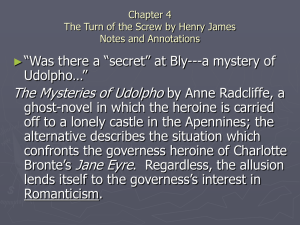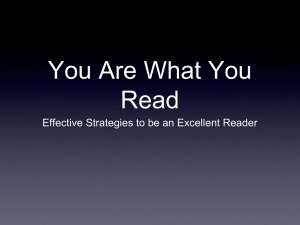Summer Reading Annotations Rubric
advertisement
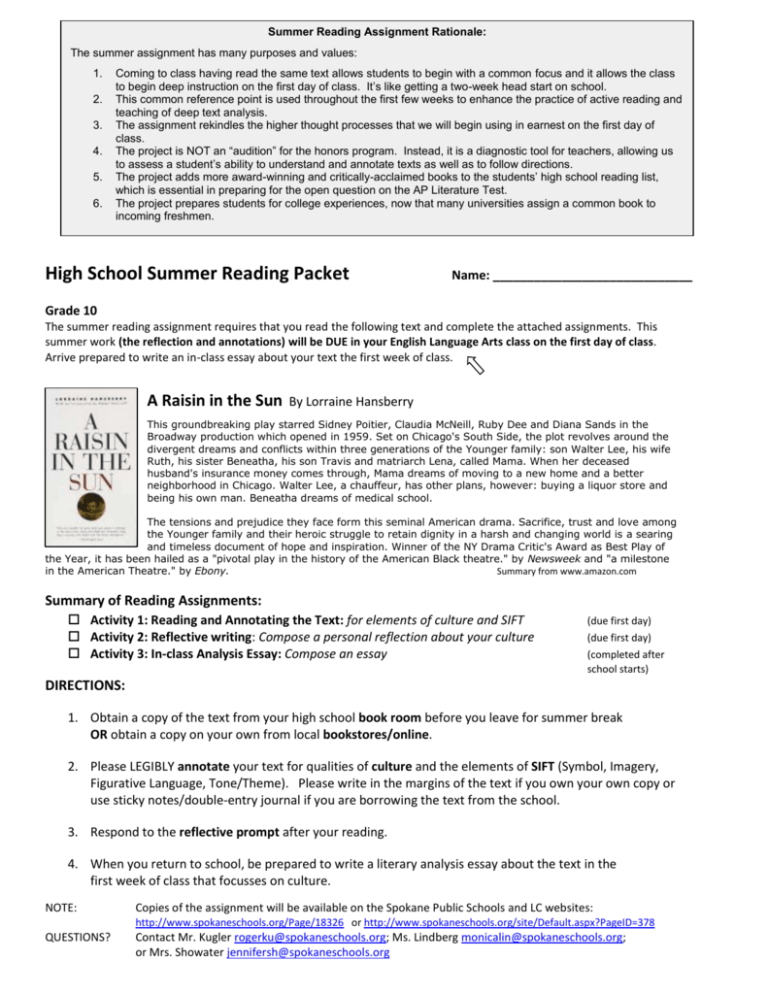
Summer Reading Assignment Rationale: The summer assignment has many purposes and values: 1. 2. 3. 4. 5. 6. Coming to class having read the same text allows students to begin with a common focus and it allows the class to begin deep instruction on the first day of class. It’s like getting a two-week head start on school. This common reference point is used throughout the first few weeks to enhance the practice of active reading and teaching of deep text analysis. The assignment rekindles the higher thought processes that we will begin using in earnest on the first day of class. The project is NOT an “audition” for the honors program. Instead, it is a diagnostic tool for teachers, allowing us to assess a student’s ability to understand and annotate texts as well as to follow directions. The project adds more award-winning and critically-acclaimed books to the students’ high school reading list, which is essential in preparing for the open question on the AP Literature Test. The project prepares students for college experiences, now that many universities assign a common book to incoming freshmen. High School Summer Reading Packet Name: _____________________________ Grade 10 The summer reading assignment requires that you read the following text and complete the attached assignments. This summer work (the reflection and annotations) will be DUE in your English Language Arts class on the first day of class. Arrive prepared to write an in-class essay about your text the first week of class. A Raisin in the Sun By Lorraine Hansberry This groundbreaking play starred Sidney Poitier, Claudia McNeill, Ruby Dee and Diana Sands in the Broadway production which opened in 1959. Set on Chicago's South Side, the plot revolves around the divergent dreams and conflicts within three generations of the Younger family: son Walter Lee, his wife Ruth, his sister Beneatha, his son Travis and matriarch Lena, called Mama. When her deceased husband's insurance money comes through, Mama dreams of moving to a new home and a better neighborhood in Chicago. Walter Lee, a chauffeur, has other plans, however: buying a liquor store and being his own man. Beneatha dreams of medical school. The tensions and prejudice they face form this seminal American drama. Sacrifice, trust and love among the Younger family and their heroic struggle to retain dignity in a harsh and changing world is a searing and timeless document of hope and inspiration. Winner of the NY Drama Critic's Award as Best Play of the Year, it has been hailed as a "pivotal play in the history of the American Black theatre." by Newsweek and "a milestone in the American Theatre." by Ebony. Summary from www.amazon.com Summary of Reading Assignments: Activity 1: Reading and Annotating the Text: for elements of culture and SIFT Activity 2: Reflective writing: Compose a personal reflection about your culture Activity 3: In-class Analysis Essay: Compose an essay (due first day) (due first day) (completed after school starts) DIRECTIONS: 1. Obtain a copy of the text from your high school book room before you leave for summer break OR obtain a copy on your own from local bookstores/online. 2. Please LEGIBLY annotate your text for qualities of culture and the elements of SIFT (Symbol, Imagery, Figurative Language, Tone/Theme). Please write in the margins of the text if you own your own copy or use sticky notes/double-entry journal if you are borrowing the text from the school. 3. Respond to the reflective prompt after your reading. 4. When you return to school, be prepared to write a literary analysis essay about the text in the first week of class that focusses on culture. NOTE: Copies of the assignment will be available on the Spokane Public Schools and LC websites: http://www.spokaneschools.org/Page/18326 or http://www.spokaneschools.org/site/Default.aspx?PageID=378 QUESTIONS? Contact Mr. Kugler rogerku@spokaneschools.org; Ms. Lindberg monicalin@spokaneschools.org; or Mrs. Showater jennifersh@spokaneschools.org Activity 1: Reading and Annotating the Text: Thinking critically and analyzing a text Annotation: the act of making notes in/on a text as you read so that it shows your critical thinking and analysis of the text. You are capturing your thinking as you read for your “future self.” Think of annotation as writing notes that provide active interaction with a text while make your thinking obvious to an outside observer. Your assignment: Please annotate your text in the margins, using sticky notes or a double-entry journal. Please note that annotating includes both marking literary elements and what you feel is the text is revealing about culture. Read the scoring rubric (attached) carefully. Your annotations should have two main focusses: Culture: the shared set of arts, ideas, skills, institutions, customs, attitude, values, and achievements that characterize a group of people, and that are passed on or taught to succeeding generations. SIFT: Focus your annotations so that they track and identify the elements of SIFT: Symbols, Image, Figurative Language, Tone, and Theme. Symbol: anything (object, animal, event, person, or place) that represents itself but also stands for something else on a figurative level. Image: a word or phrase that appeals to one or more of the 5 senses and creates a picture: visual, auditory, olfactory (smell), kinesthetic (motion/touch), gustatory (taste). Figurative Language: words or phrases that describe one thing in terms of another; not meant to be taken literally: similes, metaphors, personification. Tone: a writer or speaker’s attitude toward a subject Theme: a writer’s central idea or main message about life Three Levels of Annotation Your annotations should attend to all three levels of thinking as listed below: Level 1 Level 2 Level 3 Literal—found directly in the text Interpretive/Analytical—found by making inferences Questions/notes about the author’s choices Universal/Thematic—found outside of the text Questions/notes that check for understanding Questions/notes about how the text relates to the world outside the text, including how it relates to my life and what I know. You can choose to annotate the text for this assignment in three different ways: 1) Mark the Text OR Please obtain the text and annotate in the margins. Your teacher will collect the text and assess your annotations using the rubric. 2) Use Post-Its OR Annotate the text on post-its and place them in the book. Your teacher will collect the book and post-its to assess your annotations using the rubric. 3) Create a Double Entry Journal If you would like to interact with the text using a double entry journal, please create a journal using the annotation symbols and textual evidence to demonstrate your interaction with the text. Text and Page Number “You were the river current/carrying the roaring notes…” (lines 37-38 page 8) Connections and Insights The speaker uses a metaphor to compare her mother to the current in a fastflowing river that seems to be carrying a song. The song might represent… Activity 2: Post-Reading Reflective Writing NAME: _______________________________________ This author demonstrates that cultural identification is one way in which we create a sense of self. Cultural background and experiences create a perspective from which we understand ourselves, others and the world. Each of us belongs to different and often overlapping groups and subcultures that shape and influence our perceptions of the world around us. In the text, we learn a lot about the characters’ family, perceptions, and culture. Reflect on your own culture. What are the qualities of your own customs, family heirlooms, and holiday traditions? With the purpose/intention of introducing yourself to your teacher, describe your culture and the influence it has had on your life. Consider any of the following cultural categories in your response: Heritage Traditions/ customs Values/Beliefs Race/ethnicity School Religion/Spirituality Neighborhood Sports/Activities City/State Food Clothing/fashion Heirlooms Neatly write a FINAL DRAFT of your response in the space below or type and attach your response to this packet. You will turn in a FINAL DRAFT of your reflection with your annotations on the first day of school. __________________________________________________________________________________________________ __________________________________________________________________________________________________ __________________________________________________________________________________________________ __________________________________________________________________________________________________ __________________________________________________________________________________________________ __________________________________________________________________________________________________ __________________________________________________________________________________________________ __________________________________________________________________________________________________ __________________________________________________________________________________________________ __________________________________________________________________________________________________ __________________________________________________________________________________________________ __________________________________________________________________________________________________ __________________________________________________________________________________________________ __________________________________________________________________________________________________ __________________________________________________________________________________________________ __________________________________________________________________________________________________ __________________________________________________________________________________________________ __________________________________________________________________________________________________ __________________________________________________________________________________________________ __________________________________________________________________________________________________ __________________________________________________________________________________________________ __________________________________________________________________________________________________ ______________________________________________________________continue on another page as needed… Summer Reading Annotations Rubric Little Evidence 1 Approaching Standard 2 The student The student annotates some of annotates too few the scope of the text though sections of the text. some lapses in legibility may occur. The meanings of the student’s The student’s annotations are annotations are not sometimes difficult for a reader clear to the reader. to understand what he/she thinking as he/she read. The student’s notes do not show understanding of the text in a way that is clear to the reader The students notes are limited to highlighting without annotating the highlights The student’s annotations are limited to personal responses Adequate Annotations 3 Effective Annotations 4 The student annotates the majority of the scope of the text on a variety of levels. The annotations make clear to the reader what the writer was thinking as he/she read: The annotations attend to a variety of levels of thinking. For instance, the student: Level one: notes important main points/claims (particularly regarding culture) over the scope of the whole work. The student’s annotations are limited to personal responses or identifies literary symbols identifies significant images paraphrase more than analysis identifies most of the figurative language/rhetorical strategies in the The student may not focus passages his/her responses on cultural notes tone/connotatively charged diction qualities in the text The student does not note some comments on the form/format/structure and shifts in style/structure Level two: obvious SIFT elements used by identifies the function of language/rhetorical strategies in the passages the writer. The student does not attend to identifies the function of the style/structure makes inferences main points/claims over the scope of the whole work. evaluates the author/character’s arguments/claims and may challenge these claims Student does not identify some Level 3: obvious figurative language/rhetorical strategies at notes personal responses/emotional connections work in the passage. asks questions and theorizes answers makes connections outside of the text notes universal human behaviors, themes The student annotates the text with clear, thorough insight and apt observations. All of the annotations are easily interpreted by the reader. The student pays particular attention to analyzing the function of figurative/rhetorical strategies at work in the passage. The student recognizes patterns and identifies complicated themes at work in the text Summer Reading Reflection Rubric Little Evidence 1 The student does not describe his/her own culture and/or the student may misunderstand the prompt. Approaching Standard 2 The student does not thoroughly describe his/her own culture. The student may depend on outside The student may paraphrase/plagiarize sources without making personal information from a source without connections. giving credit to the source. The student uses few examples to The student uses too few or no support the description. examples to support the description. The student’s writing: The student’s writing: has a weak arrangement of is too brief to assess ideas that detracts from the author’s message. is illegible is illegible contains frequent errors in standard conventions that contains frequent errors in seriously interfere with standard conventions that meaning interfere with meaning the final product lacks the final product shows evidence of planning, lapses in planning, revision, revision, and/or editing. It and/or editing. It is not is not ready for publication. ready for publication. Adequate Reflection 3 Effective Reflection 4 The student provides a FINAL DRAFT that describes his/her own culture. The student perceptively describes his/her own culture on a variety of levels. The student uses relevant examples to support the description, including personal connections as necessary to convey his/her message. The student uses specific and well-chosen examples to support the description, including personal connections as necessary to effectively convey his/her message. The student’s writing: has appropriate organization The student’s writing: is aptly organized is mostly legible is legible demonstrates control of standard writing shows strong control and conventions. Though some mastery of standard errors may appear, they do conventions of written English. not seriously interfere with Either no errors appear, or they the meaning. are so slight that they do not interfere with the meaning. demonstrates planning, revision, and editing in demonstrates thoughtful preparing for publication. planning, significant revision, and careful editing in preparing for publication

